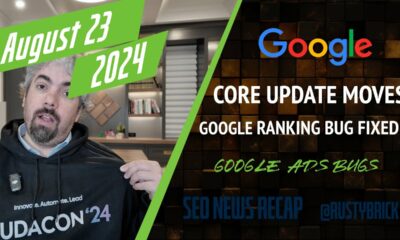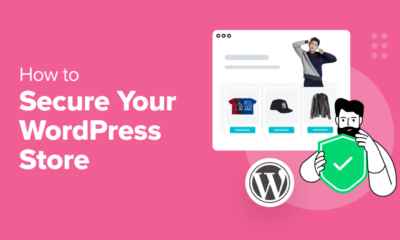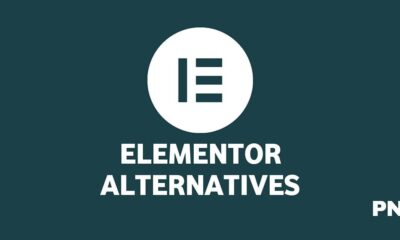SEO
The 4 Best Content Management Systems To Use In 2023

When it comes to creating a website, one of the biggest decisions a business or individual has to make is choosing a content management system (CMS).
With so many options available, it can be overwhelming to determine which one is the best fit for your specific needs.
Factors that most web developers and digital marketers alike consider include performance, flexibility, ease of use, community support, search engine optimization (SEO), and integrations with other business platforms.
Here’s my list of the best content management systems gaining traction in 2023, and some details to help you figure out which one might best suit your needs.
1. WordPress
WordPress is an open-source platform, which means that it is constantly being improved upon by a global community of developers.
The result of this is a platform that is incredibly flexible and customizable.
Whether you need to create a simple blog, a complex ecommerce website, or anything in between, WordPress has the tools and functionality to make it happen.
Furthermore, with thousands of plugins and themes available, you can easily add new features or change the look and feel of your website without needing to know how to code.
WordPress is best for individuals and businesses building a website with content at the forefront.
Popularity
WordPress is one of the most popular content management systems in the world.
In fact, it powers over 40% of all websites on the internet. This means that it has a large and active community of users who share tips and tricks and support one another.
Additionally, because it is widely used, there are countless resources available to help you get the most out of the WordPress platform, including tutorials, forums, and blogs (evidenced by the countless Google search results when searching “wordpress help”).
Search Engine Optimization (SEO)
When it comes to SEO, WordPress has a number of built-in features that make it a great choice for both businesses and individuals looking to improve their search engine rankings.
For example, it is easy to optimize your website for search engines by adding meta descriptions, keywords, and other essential elements.
Furthermore, WordPress generates clean, semantic HTML code, which is important for search engines to understand and index your content.
Additionally, there are a number of plugins available that can further improve your SEO, including Yoast SEO, All in One SEO Pack, and more.
2. Adobe Commerce (Formerly Magento)
Adobe Commerce is a powerful and flexible open-source ecommerce platform that is widely regarded as the best CMS for online stores.
With its robust feature set and user-friendly interface, Adobe Commerce makes it easy to create, manage, and grow a successful ecommerce business.
Adobe Commerce is best for ecommerce businesses building a website meant to scale.
Scalability
One of the key benefits of using Adobe Commerce for ecommerce is its ability to scale.
Whether you are just starting out with a small online store, or have an established business with thousands of products and customers, Adobe Commerce can accommodate your needs.
Its modular architecture allows you to add and remove features as your business grows, ensuring that you are always able to deliver a seamless shopping experience to your customers.
Features
In addition to its seemingly unlimited customization options, Adobe Commerce also offers a wide range of ecommerce functionality.
This includes everything from product and order management to shipping, tax calculations, payment, and security features.
With Adobe Commerce, you have everything you need to run a successful online store – all in one platform.
B2C Integrations
Another important benefit of using Adobe Commerce is its ability to integrate with a variety of third-party systems and tools geared toward B2C online business models.
This includes payment gateways, shipping providers, marketing automation tools, and more.
With Adobe Commerce, you can easily connect your online store to the systems and tools that you already use to run your business, making it easier to manage your operations and drive sales.
3. HubSpot CMS
HubSpot offers an integrated CMS platform that seamlessly connects all your marketing and sales efforts.
This integration provides a centralized platform for managing all your marketing and sales activities, including email marketing, social media management, lead generation, and customer relationship management.
The result is a streamlined workflow that enables you to easily track and manage your marketing and sales efforts, ultimately saving you time and effort.
HubSpot is best for individuals and businesses that are building a website with an integrated marketing funnel.
Landing Pages
HubSpot provides a range of customizable landing pages that can be used to promote your products and services.
These landing pages can be easily customized to match your brand and include all the information you want to share with your audience.
This is a great way to create a unique and engaging user experience for your customers and to promote your products and services effectively.
Lead Generation And Nurturing Tools
HubSpot is packed with lead generation and nurturing tools that help you to attract and convert leads into customers.
This includes lead magnets, lead forms, and lead nurturing workflows that help you to engage with your leads and guide them through the sales process.
These tools are designed to help you to generate more leads and to close more sales, ultimately helping you to grow your business.
Support And Analytics
HubSpot provides comprehensive analytics and reporting features, allowing you to track and analyze your website and marketing performance.
From website traffic and conversions to email opens and click-through rates (CTRs), you can gain valuable insights into what’s working and what needs improvement.
On top of this, HubSpot offers a wealth of resources and support to help you make the most of your CMS. From a vast library of educational content to a thriving community of users, you can get the help you need to succeed.
Additionally, HubSpot’s customer support team is available 24/7 to answer any questions or concerns you may have.
4. Hygraph (Formerly GraphCMS)
Hygraph is an enterprise-grade content management system built for industry leaders and challengers.
Hygraph is the best headless CMS for businesses looking to improve their digital experiences and reach new heights in content creation, management, and distribution.
Hygraph is best for large teams with a lot of content across multiple websites.
Performance
Hygraph is a “headless” content management system, which means it’s inherently decoupled from your website’s front end.
This helps process large amounts of data and traffic with ease, making it an ideal choice for high-traffic websites and applications.
Its powerful graph database architecture allows for fast querying and retrieval of content, ensuring that your site remains fast and responsive even as your content grows.
Additionally, Hygraph’s built-in caching and optimization features help to further improve performance, making it an excellent choice for businesses looking to deliver a fast, seamless experience to their customers.
Want to learn more about headless content management systems? Read more here.
Content Federation
Hygraph offers a unique approach to content federation, enabling you to manage and reuse content across multiple channels and platforms in a consistent and reusable way.
With Hygraph, you can create and manage your content in a single central repository, and then distribute it to multiple websites, apps, and other platforms with ease.
This makes it easier for large teams to collaborate, streamline content creation and management, and help ensure a consistent experience for your customers, regardless of where they engage with your content.
It’s perfect for businesses with a lot of cooks in the kitchen.
Content Types
Hygraph provides an intuitive and user-friendly interface that makes it easy to manage and publish content.
The platform also supports a wide range of content types, including text, images, videos, and audio.
This makes it easy for businesses to create and publish content in a variety of formats to reach their target audience.
Conclusion
When choosing a content management system, it’s important to consider the specific needs and goals of your organization, as well as the technical capabilities and resources available.
Remember that while there isn’t a “best” CMS out there, there’s probably one that’s best suited for your particular business and website.
More Resources:
Featured Image: puhhha/Shutterstock
SEO
WordPress Insiders Discuss WordPress Stagnation

A recent webinar featuring WordPress executives from Automattic and Elementor, along with developers and Joost de Valk, discussed the stagnation in WordPress growth, exploring the causes and potential solutions.
Stagnation Was The Webinar Topic
The webinar, “Is WordPress’ Market share Declining? And What Should Product Businesses Do About it?” was a frank discussion about what can be done to increase the market share of new users that are choosing a web publishing platform.
Yet something that came up is that there are some areas that WordPress is doing exceptionally well so it’s not all doom and gloom. As will be seen later on, the fact that the WordPress core isn’t progressing in terms of specific technological adoption isn’t necessarily a sign that WordPress is falling behind, it’s actually a feature.
Yet there is a stagnation as mentioned at the 17:07 minute mark:
“…Basically you’re saying it’s not necessarily declining, but it’s not increasing and the energy is lagging. “
The response to the above statement acknowledged that while there are areas of growth like in the education and government sectors, the rest was “up for grabs.”
Joost de Valk spoke directly and unambiguously acknowledged the stagnation at the 18:09 minute mark:
“I agree with Noel. I think it’s stagnant.”
That said, Joost also saw opportunities with ecommerce, with the performance of WooCommerce. WooCommerce, by the way, outperformed WordPress as a whole with a 6.80% year over year growth rate, so there’s a good reason that Joost was optimistic of the ecommerce sector.
A general sense that WordPress was entering a stall however was not in dispute, as shown in remarks at the 31:45 minute mark:
“… the WordPress product market share is not decreasing, but it is stagnating…”
Facing Reality Is Productive
Humans have two ways to deal with a problem:
- Acknowledge the problem and seek solutions
- Pretend it’s not there and proceed as if everything is okay
WordPress is a publishing platform that’s loved around the world and has literally created countless jobs, careers, powered online commerce as well as helped establish new industries in developing applications that extend WordPress.
Many people have a stake in WordPress’ continued survival so any talk about WordPress entering a stall and descent phase like an airplane that reached the maximum altitude is frightening and some people would prefer to shout it down to make it go away.
Acknowledging facts and not brushing them aside is what this webinar achieved as a step toward identifying solutions. Everyone in the discussion has a stake in the continued growth of WordPress and their goal was to put it out there for the community to also get involved.
The live webinar featured:
- Miriam Schwab, Elementor’s Head of WP Relations
- Rich Tabor, Automattic Product Manager
- Joost de Valk, founder of Yoast SEO
- Co-hosts Matt Cromwell and Amber Hinds, both members of the WordPress developer community moderated the discussion.
WordPress Market Share Stagnation
The webinar acknowledged that WordPress market share, the percentage of websites online that use WordPress, was stagnating. Stagnation is a state at which something is neither moving forward nor backwards, it is simply stuck at an in between point. And that’s what was openly acknowledged and the main point of the discussion was understanding the reasons why and what could be done about it.
Statistics gathered by the HTTPArchive and published on Joost de Valk’s blog show that WordPress experienced a year over year growth of 1.85%, having spent the year growing and contracting its market share. For example, over the latest month over month period the market share dropped by -0.28%.
Crowing about the WordPress 1.85% growth rate as evidence that everything is fine is to ignore that a large percentage of new businesses and websites coming online are increasingly going to other platforms, with year over year growth rates of other platforms outpacing the rate of growth of WordPress.
Out of the top 10 Content Management Systems, only six experienced year over year (YoY) growth.
CMS YoY Growth
- Webflow: 25.00%
- Shopify: 15.61%
- Wix: 10.71%
- Squarespace: 9.04%
- Duda: 8.89%
- WordPress: 1.85%
Why Stagnation Is A Problem
An important point made in the webinar is that stagnation can have a negative trickle-down effect on the business ecosystem by reducing growth opportunities and customer acquisition. If fewer of the new businesses coming online are opting in for WordPress are clients that will never come looking for a theme, plugin, development or SEO service.
It was noted at the 4:18 minute mark by Joost de Valk:
“…when you’re investing and when you’re building a product in the WordPress space, the market share or whether WordPress is growing or not has a deep impact on how easy it is to well to get people to, to buy the software that you want to sell them.”
Perception Of Innovation
One of the potential reasons for the struggle to achieve significant growth is the perception of a lack of innovation, pointed out at the 16:51 minute mark that there’s still no integration with popular technologies like Next JS, an open-source web development platform that is optimized for fast rollout of scalable and search-friendly websites.
It was observed at the 16:51 minute mark:
“…and still today we have no integration with next JS or anything like that…”
Someone else agreed but also expressed at the 41:52 minute mark, that the lack of innovation in the WordPress core can also be seen as a deliberate effort to make WordPress extensible so that if users find a gap a developer can step in and make a plugin to make WordPress be whatever users and developers want it to be.
“It’s not trying to be everything for everyone because it’s extensible. So if WordPress has a… let’s say a weakness for a particular segment or could be doing better in some way. Then you can come along and develop a plug in for it and that is one of the beautiful things about WordPress.”
Is Improved Marketing A Solution
One of the things that was identified as an area of improvement is marketing. They didn’t say it would solve all problems. It was simply noted that competitors are actively advertising and promoting but WordPress is by comparison not really proactively there. I think to extend that idea, which wasn’t expressed in the webinar, is to consider that if WordPress isn’t out there putting out a positive marketing message then the only thing consumers might be exposed to is the daily news of another vulnerability.
Someone commented in the 16:21 minute mark:
“I’m missing the excitement of WordPress and I’m not feeling that in the market. …I think a lot of that is around the product marketing and how we repackage WordPress for certain verticals because this one-size-fits-all means that in every single vertical we’re being displaced by campaigns that have paid or, you know, have received a a certain amount of funding and can go after us, right?”
This idea of marketing being a shortcoming of WordPress was raised earlier in the webinar at the 18:27 minute mark where it was acknowledged that growth was in some respects driven by the WordPress ecosystem with associated products like Elementor driving the growth in adoption of WordPress by new businesses.
They said:
“…the only logical conclusion is that the fact that marketing of WordPress itself is has actually always been a pain point, is now starting to actually hurt us.”
Future Of WordPress
This webinar is important because it features the voices of people who are actively involved at every level of WordPress, from development, marketing, accessibility, WordPress security, to plugin development. These are insiders with a deep interest in the continued evolution of WordPress as a viable platform for getting online.
The fact that they’re talking about the stagnation of WordPress should be of concern to everybody and that they are talking about solutions shows that the WordPress community is not in denial but is directly confronting situations, which is how a thriving ecosystem should be responding.
Watch the webinar:
Is WordPress’ Market share Declining? And What Should Product Businesses Do About it?
Featured Image by Shutterstock/Krakenimages.com
SEO
Google’s New Support For AVIF Images May Boost SEO

Google announced that images in the AVIF file format will now be eligible to be shown in Google Search and Google Images, including all platforms that surface Google Search data. AVIF will dramatically lower image sizes and improve Core Web Vitals scores, particularly Largest Contentful Paint.
How AVIF Can Improve SEO
Getting pages crawled and indexed are the first step of effective SEO. Anything that lowers file size and speeds up web page rendering will help search crawlers get to the content faster and improve the amount of pages crawled.
Google’s crawl budget documentation recommends increasing the speeds of page loading and rendering as a way to avoid receiving “Hostload exceeded” warnings.
It also says that faster loading times enables Googlebot to crawl more pages:
Improve your site’s crawl efficiency
Increase your page loading speed
Google’s crawling is limited by bandwidth, time, and availability of Googlebot instances. If your server responds to requests quicker, we might be able to crawl more pages on your site.
What Is AVIF?
AVIF (AVI Image File Format) is a next generation open source image file format that combines the best of JPEG, PNG, and GIF image file formats but in a more compressed format for smaller image files (by 50% for JPEG format).
AVIF supports transparency like PNG and photographic images like JPEG does but does but with a higher level of dynamic range, deeper blacks, and better compression (meaning smaller file sizes). AVIF even supports animation like GIF does.
AVIF Versus WebP
AVIF is generally a better file format than WebP in terms of smaller files size (compression) and image quality. WebP is better for lossless images, where maintaining high quality regardless of file size is more important. But for everyday web usage, AVIF is the better choice.
See also: 12 Important Image SEO Tips You Need To Know
Is AVIF Supported?
AVIF is currently supported by Chrome, Edge, Firefox, Opera, and Safari browsers. Not all content management systems support AVIF. However, both WordPress and Joomla support AVIF. In terms of CDN, Cloudflare also already supports AVIF.
I couldn’t at this time ascertain whether Bing supports AVIF files and will update this article once I find out.
Current website usage of AVIF stands at 0.2% but now that it’s available to surfaced in Google Search, expect that percentage to grow. AVIF images will probably become a standard image format because of its high compression will help sites perform far better than they currently do with JPEG and PNG formats.
Research conducted in July 2024 by Joost de Valk (founder of Yoast, ) discovered that social media platforms don’t all support AVIF files. He found that LinkedIn, Mastodon, Slack, and Twitter/X do not currently support AVIF but that Facebook, Pinterest, Threads and WhatsApp do support it.
AVIF Images Are Automatically Indexable By Google
According to Google’s announcement there is nothing special that needs to be done to make AVIF image files indexable.
“Over the recent years, AVIF has become one of the most commonly used image formats on the web. We’re happy to announce that AVIF is now a supported file type in Google Search, for Google Images as well as any place that uses images in Google Search. You don’t need to do anything special to have your AVIF files indexed by Google.”
Read Google’s announcement:
Supporting AVIF in Google Search
Featured Image by Shutterstock/Cast Of Thousands
SEO
CMOs Called Out For Reliance On AI Content For SEO

Eli Schwartz, Author of Product-Led SEO, started a discussion on LinkedIn about there being too many CMOs (Chief Marketing Officers) who believe that AI written content is an SEO strategy. He predicted that there will be reckoning on the way after their strategies end in failure.
This is what Eli had to say:
“Too many CMOs think that AI-written content is an SEO strategy that will replace actual SEO.
This mistake is going to lead to an explosion in demand for SEO strategists to help them fix their traffic when they find out they might have been wrong.”
Everyone in the discussion, which received 54 comments, strongly agreed with Eli, except for one guy.
What Is Google’s Policy On AI Generated Content?
Google’s policy hasn’t changed although they did update their guidance and spam policies on March 5, 2024 at the same time as the rollout of the March 2024 Core Algorithm Update. Many publishers who used AI to create content subsequently reported losing rankings.
Yet it’s not said that using AI is enough to merit poor rankings, it’s content that is created for ranking purposes.
Google wrote these guidelines specifically for autogenerated content, including AI generated content (Wayback machine copy dated March 6, 2024)
“Our long-standing spam policy has been that use of automation, including generative AI, is spam if the primary purpose is manipulating ranking in Search results. The updated policy is in the same spirit of our previous policy and based on the same principle. It’s been expanded to account for more sophisticated scaled content creation methods where it isn’t always clear whether low quality content was created purely through automation.
Our new policy is meant to help people focus more clearly on the idea that producing content at scale is abusive if done for the purpose of manipulating search rankings and that this applies whether automation or humans are involved.”
Many in Eli’s discussion were in agreement that reliance on AI by some organizations may come to haunt them, except for that one guy in the discussion
Read the discussion on LinkedIn:
Too many CMOs think that AI-written content is an SEO strategy that will replace actual SEO
Featured Image by Shutterstock/Cast Of Thousands
-

 SEO7 days ago
SEO7 days agoGoogle’s Revamped Documentation Shows 4 Reasons To Refresh Content
-
SEARCHENGINES5 days ago
Daily Search Forum Recap: August 26, 2024
-

 SEARCHENGINES7 days ago
SEARCHENGINES7 days agoGoogle Ranking Bug Fixed, August Core Update Swings, AI Overviews, Google Ads Bug & More
-
SEARCHENGINES4 days ago
Daily Search Forum Recap: August 27, 2024
-

 WORDPRESS7 days ago
WORDPRESS7 days agoHow to Secure Your WordPress Store
-

 AFFILIATE MARKETING7 days ago
AFFILIATE MARKETING7 days agoBusiness Owners are Batting 1,000 With This All-in-One Management Hub
-

 SEARCHENGINES6 days ago
SEARCHENGINES6 days agoGoogle Migrating All To Google Merchant Center Next By September
-

 WORDPRESS5 days ago
WORDPRESS5 days ago9 Best Elementor Alternatives 2024 (Faster Page Builders)















You must be logged in to post a comment Login